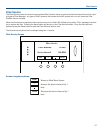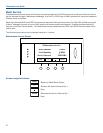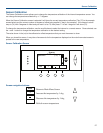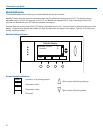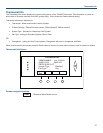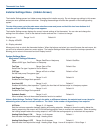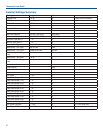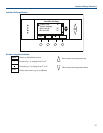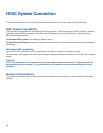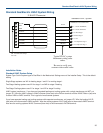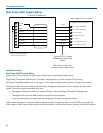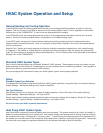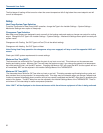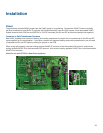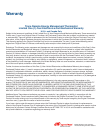31
HVAC System Operation and Setup
General Heating and Cooling Operation
In the HEATING mode, the heating system will be turned on at one degree below the setpoint and will turn off at the
setpoint. This turn on and turn off offset is referred to as the heating setpoint “delta T” and is adjustable in the Installer
Settings menu of the THERMOSTAT. It is set to the one degree operation by default.
In the COOLING mode, the cooling system will be turned on at one degree above the setpoint and will turn off at the
setpoint. Similarly, the cooling setpoint delta T is adjustable in the Installer Settings menu.
In the AUTO mode, the system will switch between heating and cooling as determined by the heating and cooling
setpoints and the current temperature. Once in a heating or cooling mode of operation, the normal one degree setpoint
control is maintained.
Setpoint Push. Heating and cooling setpoints are forced to maintain a separation between them, with a default setting
of 3 degrees. If the heating or cooling setpoint is changed to be within the setpoint delta, the system will automatically
“push” the other setpoint to maintain the setpoint delta separation. The H/C setpoint delta is also adjustable in the Installer
Settings menu of the THERMOSTAT.
Standard HVAC System Types
Gas or electric heating systems are considered “Standard” HVAC systems. These systems consist of an indoor furnace/
blower assembly and an outdoor AC condensing unit (for those systems with air conditioning installed). These systems in
general are referred to as central forced air HVAC systems.
You must configure the Thermostat to match your HVAC system type for correct system operation.
Setup
Standard System Type Selection
To configure the Thermostat for standard Gas/Electric HVAC system operation, change the Type in the Installer Settings –
System Settings – Mechanical Settings menu option to Gas/Elec.
Fan Type Selection
Gas systems typically do not require a fan output for heating operation. Set the Fan Type in the Installer Settings –
System Settings – Mechanical Settings – Fan Type to GAS.
Electric (and hydronic) heating systems typically do require a fan output with the call for heating. Set the Fan Type in the
Installer Settings – System Settings – Mechanical Settings – Fan Type to ELEC.
Be sure to check your HVAC system’s requirements.
Heat Pump HVAC System Types
Heat Pump HVAC systems are combined heating and cooling systems. The system consists of an indoor “air handler” (a
blower fan and coil assembly) and an outdoor unit. Heat pumps change from heating mode to cooling mode by switching
the refrigerant flow using a “changeover” or “reversing valve”. In both heating and cooling operation the compressor and
fan outputs are on and the state of the changeover output determines if heating or cooling is being provided. Heat pumps
can have one or two stages of compressor operation plus an optional third stage of electric heat strips.



